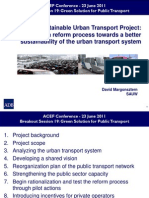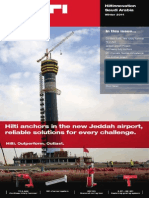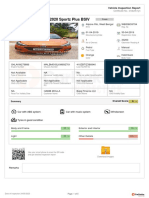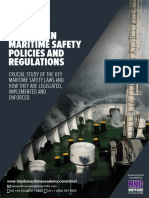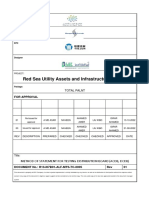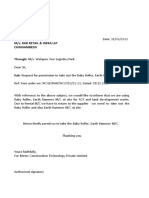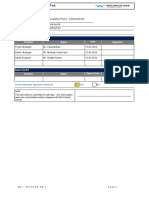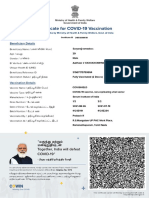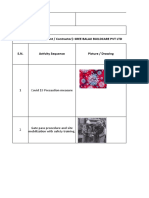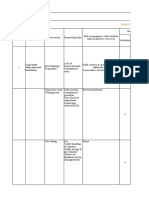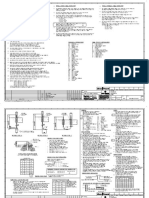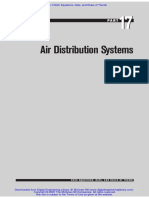Construction Induction - PowerPoint - WEB SAMPLE 1
Construction Induction - PowerPoint - WEB SAMPLE 1
Uploaded by
R. Ayyanuperumal AyyanuperumalCopyright:
Available Formats
Construction Induction - PowerPoint - WEB SAMPLE 1
Construction Induction - PowerPoint - WEB SAMPLE 1
Uploaded by
R. Ayyanuperumal AyyanuperumalOriginal Title
Copyright
Available Formats
Share this document
Did you find this document useful?
Is this content inappropriate?
Copyright:
Available Formats
Construction Induction - PowerPoint - WEB SAMPLE 1
Construction Induction - PowerPoint - WEB SAMPLE 1
Uploaded by
R. Ayyanuperumal AyyanuperumalCopyright:
Available Formats
I
Construction
Induction
(White card)
CPCCWHS1001
Prepare to work safely in the
construction industry
Includes training Industry Training Resources
tasks
Front Cover
About construction induction
© Easy Guides Australia Pty. Ltd. 7 May not be reproduced
ABOUT CONSTRUCTION INDUCTION
Workplace health and safety in the construction industry
People working in construction need proof that they have completed a general Workplace Health and Safety (WHS)
induction for the construction industry.
Previously, states and territories have had their own requirements or qualifications for a person to provide this
proof of training, for example, NSW – Green Card, VIC – Red Card, QLD – Blue Card etc.
While mutual recognition of these cards occurs between many states and territories, there is now a nationally
recognised general induction training qualification (CPCCWHS1001 Prepare to work safely in the construction
industry) which has been jointly developed and agreed upon by all state and territory health and safety
authorities.
The national qualification is commonly known as the White Card.
Note:
Keep a photocopy of your White Card.
If you happen to lose the original you
may not be allowed on the worksite
whilst you are waiting for a new card.
© Easy Guides Australia Pty. Ltd. 8 May not be reproduced
ABOUT CONSTRUCTION INDUCTION
National code of practice of induction for construction work
The code brings together best practice approaches from Australian state and territory health
and safety authorities into a framework to promote a nationally uniform approach to workplace
health and safety induction training in the building and construction industry.
This code of practice provides guidance to persons working in the general and residential
construction sectors. It covers:
• The type of induction training that may be needed to provide construction workers with an
awareness and understanding of common hazards on construction sites.
• How these hazards should be managed.
The code is supported by the Unit of Competency — CPCCWHS1001 – Prepare to work safely in the construction
industry. This unit is contained in the CPC Construction, Plumbing and Services Training Package, enabling delivery
within the VET sector.
Induction training falls into three categories
• General induction
• Site specific induction
• Task specific induction
Site specific and Task specific induction training have no formal training
or assessment requirements.
However, an employer is under a duty of care under the health and
safety Act to provide employees with information, instruction, training
and supervision as is necessary to perform their work safely.
© Easy Guides Australia Pty. Ltd. 9 May not be reproduced
ABOUT CONSTRUCTION INDUCTION
Aims of general induction training
General induction training aims to provide persons with a basic knowledge of workplace health and safety
legislative requirements, principles of risk management and the prevention of injury and illness in the
construction industry.
General induction training should be undertaken by General induction training should include a formal
anybody working in general construction (commercial training program that provides workers in the
and civil) as well as those in the residential construction industry with an awareness and
construction sector. understanding of:
• their rights and responsibilities under health
and safety law
• common hazards and risks that are in the
construction industry
• basic risk management principles
• the standard of behaviour expected of workers
on construction sites.
© Easy Guides Australia Pty. Ltd. 10 May not be reproduced
ABOUT CONSTRUCTION INDUCTION
Aims of general induction training (continued)
General induction training is recommended for:
• Anybody carrying out construction work including General induction should be completed upon entry to
site managers, supervisors, surveyors, labourers the industry before commencing construction work.
and trades persons.
However, general induction may be repeated when the
• Anybody with access to operational construction person with control of the construction work decides
zones unaccompanied or not directly that there is a need for additional training.
supervised by an inducted person.
This can be determined through supervision, incidents
• Anybody whose employment causes them to that may occur, risk management, or when a person
routinely enter operational construction zones. re-enters the industry after an extended absence; for
example, two consecutive years.
© Easy Guides Australia Pty. Ltd. 11 May not be reproduced
Element
1 - Identify health and safety legislative
requirements of construction work
This element covers the following performance criteria:
1. Basic roles, responsibilities and rights of duty holders
are identified and explained according to jurisdictional
health and safety legislative requirements.
2. Duty of care requirements are identified.
3. Construction safe work practices are identified
and explained.
© Easy Guides Australia Pty. Ltd. 13 May not be reproduced
PC 1.1 IDENTIFY HEALTH AND SAFETY LEGISLATIVE REQUIREMENTS OF CONSTRUCTION WORK
1.1 – Health & Safety Legislative requirements
Laws to keep your workplace safe
Health and safety requirements are Acts
outlined in Acts, Regulations, Codes
of Practice and Australian Standards. Acts are laws that explain how to improve health and safety in
the workplace. Check your state or territory regulator for the
current version. For example: Model Work Health and Safety Act or
Occupational Health and Safety Act.
Regulations
Regulations explain specific parts of the Act.
For example: Part 4.3 – Confined spaces, Part 4.4 – Falls
Codes of Practice/Compliance Codes
Codes of Practice are practical guidelines on how to comply with
(meet the rules of) legislation.
For example: HAZARDOUS MANUAL TASKS Code of Practice
Australian Standards
Australian Standards are work guidelines that set the minimum
accepted performance or quality for a specific hazard, process or
product. For example: AS 2550 – Cranes, hoists and winches
– safe use set.
© Easy Guides Australia Pty. Ltd. 14 May not be reproduced
PC 1.1 IDENTIFY HEALTH AND SAFETY LEGISLATIVE REQUIREMENTS OF CONSTRUCTION WORK
Examples of health and safety legislative requirements
• Duty of Care
• Construction industry health and safety standards and guidelines
• Licences, tickets or certificates of competency
• Health and safety officers/representatives, committees and supervisors
• National Code of Practice for Induction Training for Construction Work
• Health and safety, welfare and regulations
• Safety Codes of Practice.
It is important that you know about these legislative requirements and
how
they affect the work that you do.
These laws, regulations and guidelines are in place to make your worksite a
safe place to work. They are there to protect you and the workers around
you, and will help you understand your legal responsibility for health
and safety.
© Easy Guides Australia Pty. Ltd. 15 May not be reproduced
PC 1.1 IDENTIFY HEALTH AND SAFETY LEGISLATIVE REQUIREMENTS OF CONSTRUCTION WORK
National Work Health and Safety (WHS) Laws
The model WHS Act was finalised in June 2011. At the time of printing for this guide, Victoria and Western
Australia have not adopted the WHS act. The laws include a model WHS Act, model health and safety regulations,
model codes of practice and a National Compliance and Enforcement Policy.
These can be found at www.safeworkaustralia.gov.au.
States and Territories using the model WHS Acts
• Northern Territory
• Queensland
• NT
New South Wales
• Australian Capital Territory QLD
• South Australia WA
• Tasmania
Not yet adopted
SA
States not using the new laws
OHS Acts for Victoria and Western Australia can be NSW
found on the relevant regulators website.
ACT
VIC
Not yet adopted
TAS
© Easy Guides Australia Pty. Ltd. 16 May not be reproduced
PC 1.1 IDENTIFY HEALTH AND SAFETY LEGISLATIVE REQUIREMENTS OF CONSTRUCTION WORK
National Work Health and Safety (WHS) Laws (continued)
Although most states and territories have adopted the Model Act, you need to be aware of any variations that may
exist. Listed below are the acts which detail the legislative requirements for each jurisdiction (state or territory).
Australian Capital Territory
Work Health and Safety Act 2011
New South Wales
Work Health and Safety Act 2011
Northern Territory
Work Health and Safety (National Uniform Legislation) Act 2011
Queensland
Work Health and Safety Act 2011
South Australia
Work Health and Safety Act 2012
Tasmania
Work Health and Safety Act 2012
Victoria
Occupational Health and Safety Act 2004
Western Australia
Occupational Safety and Health Act 1984
© Easy Guides Australia Pty. Ltd. 17 May not be reproduced
PC 1.1 IDENTIFY HEALTH AND SAFETY LEGISLATIVE REQUIREMENTS OF CONSTRUCTION WORK
Where to find health and safety information
You can check these websites for more information about workplace health and safety.
NT WorkSafe QLD Workplace Health and Safety
www.worksafe.nt.gov.au www.justice.qld.gov.au
WA WorkSafe
www.commerce.wa.gov.au/WorkSafe
NSW WorkCover
www.workcover.nsw.gov.au
SA SafeWork
www.safework.sa.gov.au
ACT WorkCover
www.worksafe.act.gov.au
VIC WorkSafe
www.worksafe.vic.gov.au
You can also read more about health and safety at: TAS WorkSafe
www.safeworkaustralia.gov.au www.worksafe.tas.gov.au/home
© Easy Guides Australia Pty. Ltd. 18 May not be reproduced
PC 1.2 IDENTIFY HEALTH AND SAFETY LEGISLATIVE REQUIREMENTS OF CONSTRUCTION WORK
1.2 – Duty of care requirements
Note:
The following information is based on the WHS Act. If your state is not using the WHS Act (ie Victoria, Western
Australia), your trainer will provide you with the relevant section of your state Occupational Health & Safety
(OHS) Act.
‘The national WHS Act sets out the legal responsibilities that apply to persons conducting a business or undertaking
(PCBU) and workers to make sure the workplace is as safe and healthy as possible.’
PCBUs (employer/workplace manager) and workers (employees) both have a duty of care responsibility to make
sure the workplace is a healthy and safe place to be. A ‘worker’ includes people who are employees, contractors,
sub-contractors, outworkers, employees of labour hire companies and volunteers.
The workplace must also not harm the health or safety of visitors or people nearby.
© Easy Guides Australia Pty. Ltd. 19 May not be reproduced
PC 1.2 IDENTIFY HEALTH AND SAFETY LEGISLATIVE REQUIREMENTS OF CONSTRUCTION WORK
Worker’s (employee’s) duty of care PCBU’s (employer’s) duty of care
By law, as a worker you must take care of your own By law, a person undertaking a business or undertaking
health and safety — and the health and safety of PCBU has a number of obligations under the Health and
other people in the workplace. Safety Act.
You must also: These include:
• Do your best to follow reasonable safety • Provide a workplace that is safe and without risk
instructions from your PCBU/employer (boss). to health.
• Follow workplace health and safety procedures • Train workers to work in a way that is healthy and safe.
and policies. This must be in a way that is easy to understand.
• Do not do work if you • Report notifiable incidents.
believe a hazard would
• Consult (talk with) workers.
be a serious risk to your
health or safety. • Obey notices to comply with the Act.
• Make sure that all health and safety
representatives receive their training.
Penalties
If you are a PCBU/employer or worker, the government
can fine or even imprison you for failing your duty of care.
© Easy Guides Australia Pty. Ltd. 20 May not be reproduced
PC 1.2 IDENTIFY HEALTH AND SAFETY LEGISLATIVE REQUIREMENTS OF CONSTRUCTION WORK
Who has duty of care?
We have mentioned that both PCBUs (employers) and workers have
a duty of care responsibility to make sure the workplace is a
healthy and safe place to be.
On the following pages are some examples of people who have a
duty of care to make sure the workplace is a healthy and safe
place to be.
Duties of persons conducting businesses or undertakings
involving management or control of workplaces
The person with management or control of a workplace:
• must take reasonable care that the workplace is without risk to the
health or safety of anyone.
• must also make sure that people can enter and exit the workplace
without risk to their health or safety.
© Easy Guides Australia Pty. Ltd. 22 May not be reproduced
PC 1.2 IDENTIFY HEALTH AND SAFETY LEGISLATIVE REQUIREMENTS OF CONSTRUCTION WORK
Licences, tickets or certificates of competency
Some tasks will require you to hold a current licence, certificate or other qualification. Here are some
examples:
• Licences issued under the National Standard for Licensing Persons Performing High Risk work such as:
Dogging, rigging, scaffolding Forklift trucks Elevating work platforms
(over 4 metres) (boom length 11 metres or more)
Cranes Pressure equipment
© Easy Guides Australia Pty. Ltd. 26 May not be reproduced
PC 1.2 IDENTIFY HEALTH AND SAFETY LEGISLATIVE REQUIREMENTS OF CONSTRUCTION WORK
Licences, tickets or certificates of competency (continued)
Other tasks that will require you to hold a current licence,
certificate or other qualifications include:
• Traffic control
• Transporting dangerous goods
• Pilot vehicle
• Asbestos removal
• Plumbing and gas fitting
• Producing, storing and transporting prescribed waste
• Dredging
• Road works
• Laying underground services in public areas.
Do not attempt any of these tasks without the proper training and qualifications
© Easy Guides Australia Pty. Ltd. 27 May not be reproduced
PC 1.3 IDENTIFY HEALTH AND SAFETY LEGISLATIVE REQUIREMENTS OF CONSTRUCTION WORK
Safe work practices (continued)
Use of plant and equipment Personal protective equipment (PPE)
Operate plant, equipment and machinery in a safe The purpose of PPE (clothing, equipment or protective
and responsible way that does not put yourself or substances such as sunscreen) is to protect you from
others at risk. risk of injury or illness.
If you are on medication you must notify your You should use personal protective equipment and
supervisor before operating plant clothing where necessary.
machinery.
© Easy Guides Australia Pty. Ltd. 29 May not be reproduced
PC 1.3 IDENTIFY HEALTH AND SAFETY LEGISLATIVE REQUIREMENTS OF CONSTRUCTION WORK
Keeping your work area clean Storing materials and equipment
Keep your work area clean and remove and/or store Make sure that materials and equipment are:
any debris, materials or equipment.
• stored in a safe manner
Tripping hazards are common, so try to keep walkways • stored in an organised manner
clear of any debris or litter. • able to be accessed safely and easily
• stored as per Safety Data Sheet (see SDS next page)
and WHS legislative requirements.
© Easy Guides Australia Pty. Ltd. 30 May not be reproduced
PC 1.3 IDENTIFY HEALTH AND SAFETY LEGISLATIVE REQUIREMENTS OF CONSTRUCTION WORK
Litter and debris
Litter and debris can get in the way, be a tripping hazard or a fire
hazard.
Don’t let debris build up Always make sure that removal of debris
– remove it continuously does not create a risk to, or impact
throughout your day. badly on the environment.
Always dispose of
litter in approved
and marked
bins.
© Easy Guides Australia Pty. Ltd. 32 May not be reproduced
PC 1.3 IDENTIFY HEALTH AND SAFETY LEGISLATIVE REQUIREMENTS OF CONSTRUCTION WORK
Site disturbance and dust
Site disturbance could include spreading mud, dust or debris around and outside the worksite.
To help stop site disturbance you can:
Keep trucks and other vehicles on designated Spread gravel at road access points to minimise the
travel routes. amount of mud that is left on roads.
Cover loose loads to make sure
debris doesn’t fall from the back
of trucks onto the road.
© Easy Guides Australia Pty. Ltd. 33 May not be reproduced
PC 1.3 IDENTIFY HEALTH AND SAFETY LEGISLATIVE REQUIREMENTS OF CONSTRUCTION WORK
Site disturbance and dust (continued)
Control dust by wetting roads and stockpiles Make sure stormwater drains in the area have been
(water restrictions permitting). set up with a gravel sausage or gravel inlet filter to
stop mud making its way into the stormwater system.
Clean truck tyres
with a broom or
water to
prevent mud
spreading onto
the road.
Procedures and processes for controlling hazards will need to be reviewed on a regular basis as
workplaces can be constantly changing.
© Easy Guides Australia Pty. Ltd. 34 May not be reproduced
PC 1.3 IDENTIFY HEALTH AND SAFETY LEGISLATIVE REQUIREMENTS OF CONSTRUCTION WORK
Bullying and harassment Smoking in the workplace
Take care of yourselves and each other. Some workplaces have special places for people who
smoke. If you smoke, you must use these places to
Bullying and harassment do not belong in the prevent a risk to others who do not smoke. It also
workplace. Report any bullying or harassment to removes the risk of a flame near flammable liquids.
your supervisor or other relevant person.
Some sites may also have set smoking times.
© Easy Guides Australia Pty. Ltd. 35 May not be reproduced
Element 2 - Identify construction
hazards and risk control measures
This element covers the following
performance criteria:
1. Basic principles of risk
management are
identified.
2. Construction hazards
are identified
and discussed.
3. Purpose and use of PPE
are
identified and
demonstrated.
© Easy Guides Australia Pty. Ltd. 39 May not be reproduced
4. Measures for controlling
hazards
are identified.
PC 2.1 IDENTIFY CONSTRUCTION HAZARDS AND RISK CONTROL MEASURES
2.1 – Basic principles of risk management
Hazard versus risk
What is the difference?
The constantly changing nature of construction work sets it apart from other types of work. Different hazards and
risks emerge constantly—sometimes instantly.
Co-ordinating risk management is made more difficult by the stop and start nature of a construction project, high
turnover of workers and temporary workplaces. These features contribute to the high levels of risk in the industry.
Hazard Risk
A hazard is any thing or any situation which could A risk is the chance of a hazard causing injury
injure or harm you. or harm.
In other words, it is anything that can hurt you. In other words, how likely it is that somebody
or something may be harmed by the hazard.
© Easy Guides Australia Pty. Ltd. 40 May not be reproduced
You might also like
- Method Statement For Painting System KAFD-RY-RIA2-CP04-SAB-ARF-MES-05001 Rev.01Document13 pagesMethod Statement For Painting System KAFD-RY-RIA2-CP04-SAB-ARF-MES-05001 Rev.01khalid khanNo ratings yet
- ROUTINE MAINTENANCE Sep2016-SlideDocument12 pagesROUTINE MAINTENANCE Sep2016-SlideKhairul Rizan RazduanNo ratings yet
- BS5489-6 1992Document13 pagesBS5489-6 1992GEO MSc Group-2016No ratings yet
- As 4920-2003 (Reference Use Only) General Conditions of Contract For The Provision of Asset Maintenance and SDocument9 pagesAs 4920-2003 (Reference Use Only) General Conditions of Contract For The Provision of Asset Maintenance and SSAI Global - APACNo ratings yet
- A Report To CidbDocument29 pagesA Report To Cidbmrlobbo100% (1)
- Long and Collins 1999 IEI Piling in RockDocument22 pagesLong and Collins 1999 IEI Piling in RockShane50% (2)
- Schedule B - 8259Document8 pagesSchedule B - 8259mohamedNo ratings yet
- Aham Company Profile 2011-1Document89 pagesAham Company Profile 2011-1alicarlos13No ratings yet
- David Margonsztern - Kathmandu Sustainable Urban Transport ProjectDocument22 pagesDavid Margonsztern - Kathmandu Sustainable Urban Transport ProjectAsia Clean Energy ForumNo ratings yet
- SUDAIR-HSE-PR-012-01-PPE ManagementDocument19 pagesSUDAIR-HSE-PR-012-01-PPE ManagementGerardoNo ratings yet
- COTM 3201 Specification and Quantity Survey: University of GondarDocument36 pagesCOTM 3201 Specification and Quantity Survey: University of GondarChala Giduma WakjiraNo ratings yet
- Declaration 206AB and 206CCA For Vendor & CustomerDocument2 pagesDeclaration 206AB and 206CCA For Vendor & CustomerAbhimanyu100% (2)
- Moonlight Contracting & Cleaning Profile.Document62 pagesMoonlight Contracting & Cleaning Profile.riyazNo ratings yet
- Sample Tender DocumentDocument26 pagesSample Tender DocumentAnish BabuNo ratings yet
- 1TB01006 006C22 Ste MTS Ci 0027Document35 pages1TB01006 006C22 Ste MTS Ci 0027asifnazir.gill08No ratings yet
- Revised Submission 4 June 21Document43 pagesRevised Submission 4 June 21Rajeev TalwarNo ratings yet
- Controller Specification - 1 - 21 - TranslateDocument32 pagesController Specification - 1 - 21 - Translategrangsang isuzuNo ratings yet
- Safety EngineeringDocument112 pagesSafety EngineeringT. Rajpradeesh MECH-LECT100% (1)
- Planning and Design For Safety PDFDocument141 pagesPlanning and Design For Safety PDFFaizalNo ratings yet
- VACC Automotive Environmental GuideDocument40 pagesVACC Automotive Environmental Guidesgvfnbfhg100% (1)
- Fire Safety Guideline Rubber Tyre StorageDocument14 pagesFire Safety Guideline Rubber Tyre Storageraid raidNo ratings yet
- Mohammed Ashiq - CV - Mechanical EngineerDocument3 pagesMohammed Ashiq - CV - Mechanical EngineerAshiq NishmaNo ratings yet
- Services Avoidance Group - Expectations Guidance - Rev 3 - July 2019Document16 pagesServices Avoidance Group - Expectations Guidance - Rev 3 - July 2019wluzhengNo ratings yet
- KPT TenderDocument158 pagesKPT TenderImran MulaniNo ratings yet
- Hilti Saudi Arabia Hiltinnovation Winter 2014Document16 pagesHilti Saudi Arabia Hiltinnovation Winter 2014chadnileNo ratings yet
- Handbook-Uae enDocument233 pagesHandbook-Uae enJYOTI TALUKDARNo ratings yet
- 111status of Elimination of NTBs September 2015Document25 pages111status of Elimination of NTBs September 2015Frontyardservices Uganda limitedNo ratings yet
- Oman RailwayDocument16 pagesOman RailwaySanthosh Kumar0% (1)
- Manual CDM 625Document322 pagesManual CDM 625RODRIGO ALVES DA COSTANo ratings yet
- As 4919-2003 (Reference Use Only) General Conditions of Contract For The Provision of Asset Maintenance and SDocument9 pagesAs 4919-2003 (Reference Use Only) General Conditions of Contract For The Provision of Asset Maintenance and SSAI Global - APACNo ratings yet
- Health and SafteyDocument32 pagesHealth and SafteySagar SarkerNo ratings yet
- GV51 Visit NRA 20230423103157 PDFDocument3 pagesGV51 Visit NRA 20230423103157 PDFAli AhmiaNo ratings yet
- KQLP Safety Management Plan Draft Web2Document284 pagesKQLP Safety Management Plan Draft Web2Arthur OllivierreNo ratings yet
- Labour Force Report January 2022Document42 pagesLabour Force Report January 2022Vicki TingNo ratings yet
- HSE-BMS-019 Excavations SafetyDocument34 pagesHSE-BMS-019 Excavations Safetykhan jadoonNo ratings yet
- Environment, Health and SafetyDocument2 pagesEnvironment, Health and SafetyGiftson ImmanuelNo ratings yet
- Design Manual For Urban Roads and StreetsDocument165 pagesDesign Manual For Urban Roads and StreetsJohn DoughNo ratings yet
- Annual Report 21-22-1Document116 pagesAnnual Report 21-22-1ranjitrajivNo ratings yet
- Six Construct: Attachment No. 1 To Letter 915Document6 pagesSix Construct: Attachment No. 1 To Letter 915Reda El-DahshoryNo ratings yet
- CarDekho TrustMark Condition Report 1739905Document5 pagesCarDekho TrustMark Condition Report 1739905zaid AhmedNo ratings yet
- Thengwe Minutes of Progress Review Meeting 23Document24 pagesThengwe Minutes of Progress Review Meeting 23Kameel BhakwathidinNo ratings yet
- Join Airline PricingDocument157 pagesJoin Airline Pricingvenkata durga prasad chagantipatiNo ratings yet
- Diploma in Maritime Safety Policies and Regulations UPDATEDocument9 pagesDiploma in Maritime Safety Policies and Regulations UPDATEFranko Encalada ValenciaNo ratings yet
- Volvo Trucks FH, FM and FMX India Press ReleaseDocument3 pagesVolvo Trucks FH, FM and FMX India Press ReleaseRushLaneNo ratings yet
- Detail Sheet F Shape Concrete Barrier Permanent Dec 2020Document6 pagesDetail Sheet F Shape Concrete Barrier Permanent Dec 2020captaincharizma07No ratings yet
- PCMTBE Turn Around 2020 Specific HSE Requirements v3 PDFDocument50 pagesPCMTBE Turn Around 2020 Specific HSE Requirements v3 PDFooo oooNo ratings yet
- All Rail Freight TariffDocument1 pageAll Rail Freight Tariffsoumyarm942No ratings yet
- Defence Standard 00-25 Human Factors (Part01) - IntroductionDocument9 pagesDefence Standard 00-25 Human Factors (Part01) - IntroductionAndrew ReidNo ratings yet
- W3 Concrete and IBS ConstructionDocument86 pagesW3 Concrete and IBS ConstructionSyazwani ArifahNo ratings yet
- Egypt - Egyptian Nuclear Program StrategyDocument13 pagesEgypt - Egyptian Nuclear Program StrategyMahmoud ElboraeNo ratings yet
- Re 2Document109 pagesRe 2Syed AhmedNo ratings yet
- (FHWA, 2008) Pavement Management Systems Peer Exchange Program ReportDocument42 pages(FHWA, 2008) Pavement Management Systems Peer Exchange Program Reportali faresNo ratings yet
- NUST Yearbook Part 9 - Centre For Open and Lifelong LearningDocument113 pagesNUST Yearbook Part 9 - Centre For Open and Lifelong LearningDitend TeshNo ratings yet
- Fire and Security Legislation in UKDocument3 pagesFire and Security Legislation in UKTestingtoolNo ratings yet
- Standards PersonalprotectiveequipmentDocument22 pagesStandards PersonalprotectiveequipmentMr TibsNo ratings yet
- SRF-Serviced Plots-Manual Submission ONLYDocument1 pageSRF-Serviced Plots-Manual Submission ONLYARUL SANKARANNo ratings yet
- HB N301eDocument143 pagesHB N301edragon101010No ratings yet
- Hsg97 Coshh Step by Step PDFDocument53 pagesHsg97 Coshh Step by Step PDFsherif9000No ratings yet
- R13 I07b01 Alf MTS TC 0005Document37 pagesR13 I07b01 Alf MTS TC 0005SulimanNo ratings yet
- Kafd Systra PHB Te All LST 4040 A2 Master Vol 2 Part 4&5 EpcoDocument77 pagesKafd Systra PHB Te All LST 4040 A2 Master Vol 2 Part 4&5 EpcoJuan Dela Cruz0% (1)
- Code of Practice Construction SSW PDocument117 pagesCode of Practice Construction SSW PRafael FonsecaNo ratings yet
- Wel 16 - 28Document3 pagesWel 16 - 28R. Ayyanuperumal AyyanuperumalNo ratings yet
- EHS Walk / Inspection: Welspun One Logistics ParksDocument4 pagesEHS Walk / Inspection: Welspun One Logistics ParksR. Ayyanuperumal AyyanuperumalNo ratings yet
- M/S. Rar Retail & Infra LLP Chinnambedu Through: M/s. Welspun One Logistics ParkDocument1 pageM/S. Rar Retail & Infra LLP Chinnambedu Through: M/s. Welspun One Logistics ParkR. Ayyanuperumal AyyanuperumalNo ratings yet
- Certificate 2Document1 pageCertificate 2R. Ayyanuperumal AyyanuperumalNo ratings yet
- Work Method StatementDocument20 pagesWork Method StatementR. Ayyanuperumal AyyanuperumalNo ratings yet
- Welspun One Logistics Parks: Hazard Risk AssessmentDocument2 pagesWelspun One Logistics Parks: Hazard Risk AssessmentR. Ayyanuperumal AyyanuperumalNo ratings yet
- MSRA For DICV - Fixing of ShutterDocument3 pagesMSRA For DICV - Fixing of ShutterR. Ayyanuperumal AyyanuperumalNo ratings yet
- Plant & Equipment RegisterDocument1 pagePlant & Equipment RegisterR. Ayyanuperumal AyyanuperumalNo ratings yet
- CertificateDocument1 pageCertificateR. Ayyanuperumal AyyanuperumalNo ratings yet
- CertificateDocument1 pageCertificateR. Ayyanuperumal AyyanuperumalNo ratings yet
- Safety Non-Conformance-040121Document2 pagesSafety Non-Conformance-040121R. Ayyanuperumal AyyanuperumalNo ratings yet
- EHS Training Attendance SheetDocument5 pagesEHS Training Attendance SheetR. Ayyanuperumal AyyanuperumalNo ratings yet
- Hse Hra FF 02Document8 pagesHse Hra FF 02R. Ayyanuperumal AyyanuperumalNo ratings yet
- HIRA Cage Ladder & Life Line Installation01Document3 pagesHIRA Cage Ladder & Life Line Installation01R. Ayyanuperumal Ayyanuperumal100% (1)
- MSRA FOR Line Marking WorkDocument24 pagesMSRA FOR Line Marking WorkR. Ayyanuperumal Ayyanuperumal100% (1)
- HIRA Cage Ladder InstallationDocument9 pagesHIRA Cage Ladder InstallationR. Ayyanuperumal AyyanuperumalNo ratings yet
- BOQUIREN CADD PLATE 1-Model.P1Document1 pageBOQUIREN CADD PLATE 1-Model.P1Joshua Panopio BoquirenNo ratings yet
- NSP-Traing Canals&Canal Lining ModifiedDocument46 pagesNSP-Traing Canals&Canal Lining ModifiedSubhranshu Dwibedi100% (1)
- Bridge GulliesDocument34 pagesBridge GulliesJpolyPolyNo ratings yet
- CBR ProjectDocument46 pagesCBR ProjectChau Suktana EnlingNo ratings yet
- Major Architecture Forms From Arunachal PradeshDocument7 pagesMajor Architecture Forms From Arunachal PradeshCharchil Saini100% (1)
- Notes: General Steel Fabrication Notes: Carbon Steel Fabrication Notes: Stainless Steel FabricationDocument6 pagesNotes: General Steel Fabrication Notes: Carbon Steel Fabrication Notes: Stainless Steel FabricationAquiles MartinezNo ratings yet
- Concrete Mixtures151 200Document50 pagesConcrete Mixtures151 200Narcisa RudnicNo ratings yet
- Tech Tip 2 PDFDocument5 pagesTech Tip 2 PDFaziez_rahmawanNo ratings yet
- Ecopy-CP 83-2-2000 PDFDocument60 pagesEcopy-CP 83-2-2000 PDFHung NguyenNo ratings yet
- B Vicinity Map A Perspective: Idesia LipaDocument15 pagesB Vicinity Map A Perspective: Idesia LipaJohn Paul Dela FuenteNo ratings yet
- Caution: AMEREC AK4.5, AK7.5, AK11 and AK14 Steambath GeneratorsDocument26 pagesCaution: AMEREC AK4.5, AK7.5, AK11 and AK14 Steambath GeneratorsWilber MontenegroNo ratings yet
- Workplate D3 Gas PDFDocument1 pageWorkplate D3 Gas PDFOdaliz Rivera CamachoNo ratings yet
- Standards StudyDocument34 pagesStandards StudyHARISH KARTHICK VNo ratings yet
- 17 - Air Distribution SystemsDocument50 pages17 - Air Distribution SystemsNguyễn Đỗ Phước100% (1)
- 2014.01.08 - Moment Connections To HSS ColumnsDocument49 pages2014.01.08 - Moment Connections To HSS ColumnsUALU33389% (9)
- LUCERIANO Report SummaryDocument9 pagesLUCERIANO Report SummaryViron Luceriano100% (1)
- Material Properties 2 Miguel TamayoDocument2 pagesMaterial Properties 2 Miguel TamayoMIGUEL ANDRES TAMAYO LOPEZNo ratings yet
- A03-012 (S-MMS Installation Manual) - Air ConditioningDocument176 pagesA03-012 (S-MMS Installation Manual) - Air ConditioningEdzelDawnGarciaDayritNo ratings yet
- Cable Specification 400kV 1200SQDocument4 pagesCable Specification 400kV 1200SQluis lopezNo ratings yet
- Model For Indirect Determination of The Tensile Stree-Strain Curve Carmona2012Document13 pagesModel For Indirect Determination of The Tensile Stree-Strain Curve Carmona2012MICHAEL MWONGANo ratings yet
- Jm-Hector Aguilar CeramicosDocument10 pagesJm-Hector Aguilar CeramicosHector TrejoNo ratings yet
- Design and Analysis of High Pressure Door With Stiffened PlateDocument12 pagesDesign and Analysis of High Pressure Door With Stiffened PlateSyed Faiz Quadri100% (1)
- Silma WebinarDocument26 pagesSilma Webinartotojul1No ratings yet
- Method Statement Field Fabrication and Installation Underground Piping For Fire Line Work Pkg-2Document17 pagesMethod Statement Field Fabrication and Installation Underground Piping For Fire Line Work Pkg-2Afrizal MegadanaNo ratings yet
- 4 Design of SlabsDocument5 pages4 Design of SlabsWilkenn TuazonNo ratings yet
- Architects Service Proposal - PDFDocument10 pagesArchitects Service Proposal - PDFKapehan Ni MaestroNo ratings yet
- VO Thesis Proposal 082716Document35 pagesVO Thesis Proposal 082716Victor Okhoya100% (1)
- Journal of Safety, Health & Environmental Research: This IssueDocument34 pagesJournal of Safety, Health & Environmental Research: This IssueMaiko Lesmana DNo ratings yet
- Concepts of Sustainable BuildingDocument29 pagesConcepts of Sustainable BuildingkomalNo ratings yet








